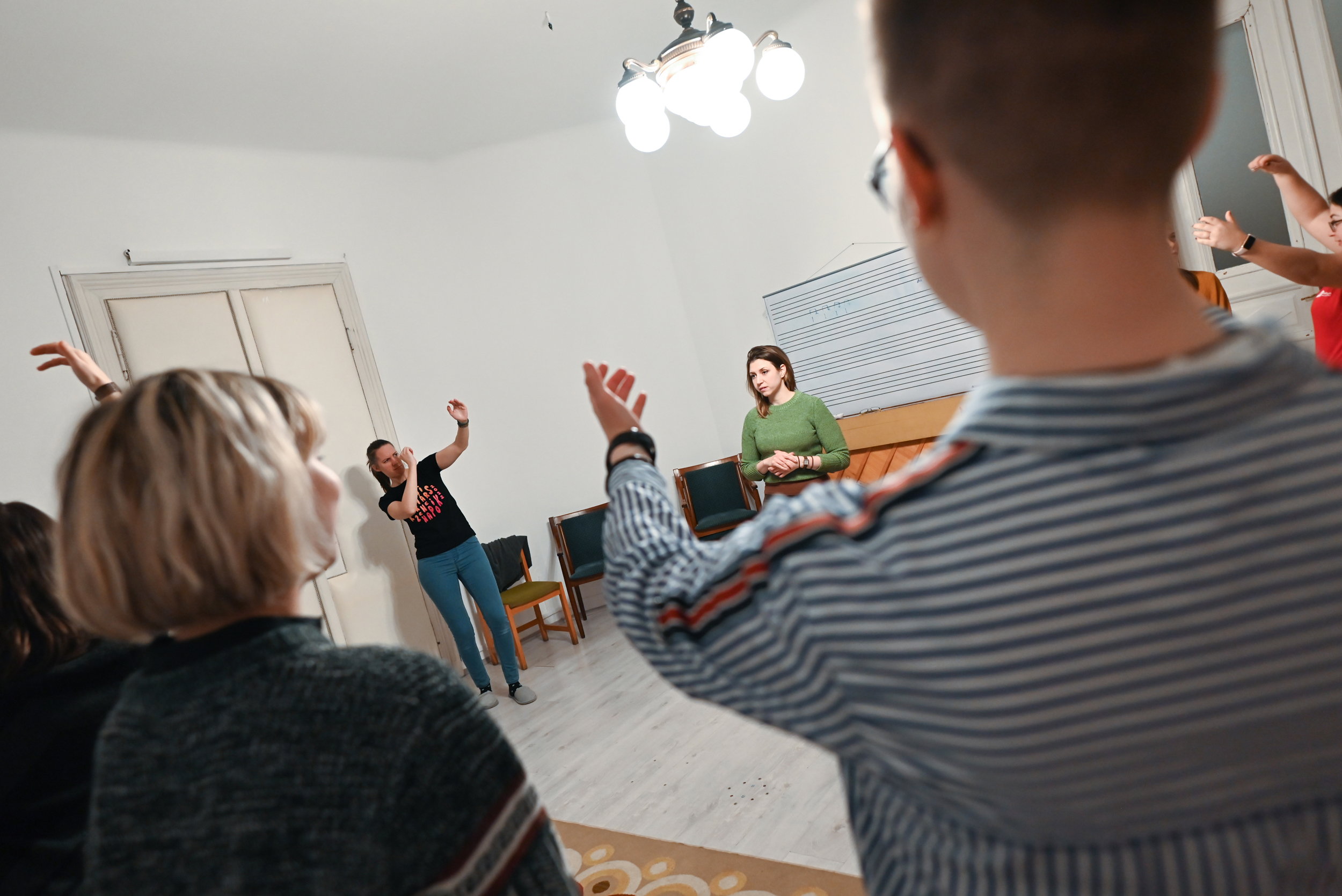by immusic | Nov 29, 2022
Category
rhythmic
instrumental
Age
8+
Number of participants
8-12
Duration
approx. 20 min.
Working method
group work
Musical abilities of the trainers
12 3 4 5 6
Equipment and instruments
- recorder or any other musical instrument
Competences
- creativity
- improvisation
- attention
- collaboration
- cooperation
- social sensitivity
The Seeker
A short game that playfully focuses on rhythm and music.
Rhythmic and instrumental version of „Hunt the object” vocal game (41).
AIM
This game develops musical skills and better recognition of tempo, rhythm, differences in sounds and dynamics. It helps them learn how to express their feelings, how to improvise, how to enjoy music and develop this within a group that develops social skills and teamwork.
Description
First the facilitator hides a small object from the participant.
When participant starts to search for the object, the facilitator or preferably the participants helps with a recorder (or other musical instrument) to find it:
• the higher the sound is on the recorder, the closer the seeker
got to the object
• the lower the sound is on the recorder, the more far the seeker
got to the object
• when reaching very closely to the subject, the highest sound to
be created quickly a few times
Level up!
The game can be expanded as follows: there is a new participant who helps the searcher, the „controller”. The controller joins the game with an instrument and helps the seeker in which direction to go with prearranged signals. For example: a loud sound means right, a quieter sound means left, repeating a sound means forward, a trill means going backwards, etc.
Since two instruments are playing at the same time, it is worth coordinating so that they sound harmoniously.
by immusic | Nov 28, 2022
Category
vocal
rhythmic
instrumental
Age
12+
Number of participants
5-20
Duration
approx. 20 min.
Working method
group work
Musical abilities of the trainers
12 3 4 5 6
EQUIPMENT
AND INSTRUMENTS
- optional: any type
of instrument
Competences
- improvisation
- creativity
- collaboration
- attention
- cooperation
- concentration
- sense of rhythm
Bead String
Short funny game to develop musical creativity and memory.
AIM
The goal of the game is to develop musical creativity, to promote thinking that always presents new and variation possibilities during the game. Musical memory improvement affects learning abilities in all other areas as well.
Description
The participants stand or sit in a circle. The facilitator provides instructions on the game and which set of sounds can be used during the play.
First participant sings or play a sound.
After that the next participant repeats the sound and adds one.
The next repeats the 2 sounds and adds another sound.
And it goes round the circle.
The goal is to make the longest line of sounds, longest “string of bead.”
Level up!
If the group’s level of knowledge and experience allows it, the game can also run to the point where a common piece can be created.
COMMENTS FOR FACILITATORS
During the activities be care of the steady beat.
by immusic | Nov 28, 2022
Category
vocal
instrumental
Age
8+
Number of participants
2-15
Duration
approx. 20 min.
Working method
- group work
- it can be played in pairt
Musical abilities of the trainers
12 3 4 5 6
Equipment and instruments
- optional: any type of instrument
Competences
- improvisation
- creativity
- memory
- collaboration
- attention
- cooperation
- concentration
Playback
A short and simple game based on creativity and improvisation.
AIM
During the game, the development of improvisational skills and creativity is the most important goal, while the musical memory also improves a lot, and paying attention to each other greatly affects social skills.
Description
The participants stand or sit in a circle. The facilitator provides instructions on the game and which set of sounds can be used during the play.
First participant sings or plays a set of sounds. First of all, it is worth choosing a simple melody that varies 2-3 notes.
After that the next participant repeats the exact same set of sounds. If this participant sang or played correctly then chooses who will go next (cannot choose the one sang/played before) and improvises a set of sounds, starting with the same note as the last set of sound ended with.
The next participant repeats the same as the player before.
During the game if somebody cannot repeat the set of sounds goes out of the circle as being out of the game. The game ends when only one participant remains in the circle.
by immusic | Nov 28, 2022
Category
vocal
instrumental
Age
12+
Number of participants
5-25
Duration
approx. 20 min.
Working method
group work
Musical abilities of the trainers
12 3 4 5 6
Competences
- creativity
- improvisation
- attention
- movement coordination
- cooperation
- social sensitivity
Sculpture Game
A funny game based on movement coordination and quick reaction
AIM
During the game, moving to the music, reacting quickly to silence, and turning into a statue all strengthen movement coordination, and at the same time this game is extremely enjoyable and has team-building benefits.
Description
The players line up next to each other at the theoretical starting line. Several meters in front of them, a participant is standing backwards towards them.
The aim of the game is for the participants on the starting line to reach and touch the shoulder of the lone player. Whoever achieves this wins. The player in front starts playing music (sings, plays an instrument, or even plays music from an application).
Players standing in the line can only move during the music and approach the target. However, as soon as the music stops, they must avoid all movement and become a statue.
The individual player turns quickly, as his goal is to discover who has moved into it. When the music stops, he looks back and if he sees someone moving, those participants must go back to the starting line (or they are out of the game, both versions can be played).
by immusic | Nov 28, 2022
Category
vocal
instrumental
Age
15+
Number of participants
5-30
Duration
approx. 30 min.
Working method
group work
Musical abilities of the trainers
1 2 3 4 5 6
Equipment and instruments
- optional: any type of instrument
Competences
- individual responsibility
- creativity
- attention
- cooperation
- concentration
- singing together
Conductor
The game draws attention to the challenges and excitement of a leadership role, such as that of a conductor.
AIM
The activities provide participants with the opportunity to learn first-hand certain musical characteristics: tempo, dynamics and timbre. For all of this, we have chosen a suitable and easy melody as an example, which can be easily sung by participants who are not familiar with music.
Description
The first task is to find the song that the majority of the group knows well, sing it several times so that everyone knows it confidently.
One participant is chosen to be the conductor (the instructor can be the conductor for the first time to show the group what to do). They can choose a song, e.g. Oh I’m going to sing.
The instructor explains that when the conductor raises his arms higher in the air, he wants the participants to sing louder. If the conductor holds his arms lower, the group should sing more softly. In addition, the conductor can indicate start (e.g. thumbs up) and stop signals (e.g. flat hand towards them). The group can agree on which notation to use for slowing down and speeding up the tempo. So, you can freely expand the instructions and markings.
Level up!
Once the participants are familiar with this activity, we can let the group, the „band”, use body instruments or rhythm instruments.
We could also divide the participants into groups of similar instruments, where the conductor controls the dynamics of each group when he gets close to them.








Recent Comments